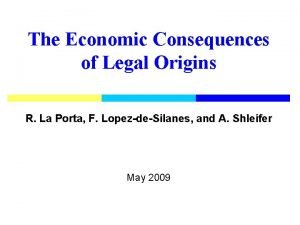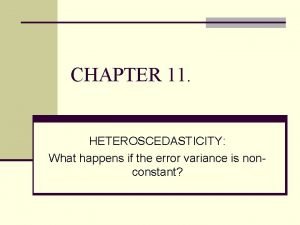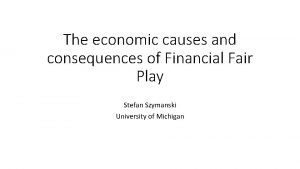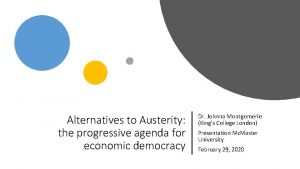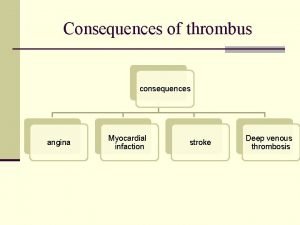EU Austerity Economic Causes Economic Consequences IER Conference
















- Slides: 16

EU Austerity Economic Causes – Economic Consequences IER Conference 9 February 2016

Overview CAUSES • • • the neo-liberal assumptions of the 1986 Single Europe Act and subsequent treaties the contradictions between these assumptions and the real world the resulting financial crisis and the subsequent political use of the crisis CONSEQUENCES • Increasing inequality of power between capital and labour and forcing down the wage share in national income • Increasing inequalities of development between states within the EU • Exporting crisis to the rest of the world

Origins 1986 Single European Act • Neo-liberal Assumptions • National Objectives Competition will maximise growth Free movement of capital, labour, goods and services: end to public monopolies Governments must not interfere with demand An end to Keynesian pump priming; unemployment maximises labour competition Cecchini Report: 5 million jobs

Contradictions between assumptions and the real world Country Percentage increase in German exports between German imports from 1998 and 2006 to Inequality of productive capacity across the EU Greece 126 19 Ireland 120 15 Portugal 53 -2 Spain 123 56 Table 1 Percentage increase in German imports and exports (by value) 1998 -2006: based on euros at current value (selected countries) Source: Eurostat, External and Intra European Union Trade: Statistical Yearbook 2008 edition: Table 5 B[i]

Contradictions Public spending restricted; Bank borrowing not Country Total exposure dollars billions Germany 733 France 823 Japan 132 UK 453 US 236 Table 2 Exposure of banks to debt in Greece, Ireland, Italy, Spain and Portugal 2009 Q 3

Contradictions Strength of collective bargaining across the EU Sole focus of EU reform activity Lisbon Programme 2000 How to create flexible and competitive labour markets: reduce ‘disincentives to work’ and ‘early exit from employment; poverty reduction linked to employability • Updated Lisbon Programme 2005/EU 2020 • Services Directive 2006: posted workers • ECJ judgements 2007 -08: Viking, Laval, Ruffert, Luxemburg • Modernising Labour Law White Paper 2007: Flexicurity

EU Crisis Combines economic imbalance with City of London leverage Table 3 Gearing of banks 2009 Q 3 Country Short-term funding Bank capital to assets Germany 30 per cent assets 4 per cent France 26 5 UK 23 7 US 19 10

Crisis A neo-liberal solution • • • No EU transfer funding No monetary boost to demand Bank funding reversed Governments made liable for banking debts: immediate payment Reform Programmes mandate attack on collective bargaining and labour rights, on state sectors.

Consequences Forcing down the Labour Share of Income: labour flexibility; labour mobility Country Unemployment 2012 Worker Compensation as per cent of GDP 2008 Worker Compensation as per cent of GDP 2014 Britain 7. 9 52. 2 49. 2 Germany 5. 4 48. 5 50. 9 Ireland 10. 7 43. 4 37. 4 Greece 24. 5 34. 0 32. 8 Spain 24. 8 50. 1 47. 1 Portugal 15. 8 46. 8 44. 2

Consequences Forcing down labour share 2 PORTUGAL NATIONAL REFORMPROGRAMME 2015 “To encourage job creation in open-ended contracts and address duality, severance payments for permanent contracts have been reduced, while the definition of fair dismissals has been eased. Working time has become more flexible to contain employment fluctuations over the cycle, accommodate differences in work patterns across sectors and firms better, and enhance firms’ competitiveness. To facilitate wage adjustment, measures have been taken to increase scope for bargaining at firm level. Unemployment insurance benefits have been revised to increase incentives for a rapid return to work, while guaranteeing a sufficient level of protection and easing eligibility The number of sectoral collective agreements fell from 172 in 2008 to 36 in 2012, while the number of extensions fell from 137 to 12 in the same period. Firm-level collective agreements also declined considerably. The number of employees covered by collective agreements fell from almost 1. 9 million in 2008 to some 225, 000 in 2014. ”

Consequences: Impact on uneven development: investment, growth Country Percent change in gross fixed capital investment: 2012 compared with 2008 Unemployment 2012 Britain -0. 4 7. 9 Germany +6. 3 5. 4 Italy -15. 0 10. 7 Greece -61. 4 24. 5 Spain -36. 2 24. 8 Portugal -35. 0 15. 8 Table 6 Annual increase in GDP: Germany and the 19 country Eurozone Area 2008 2009 2010 2011 2012 2013 2014 Germany 1. 1 0. 5 -5. 6 -4. 5 4. 1 2. 1 3. 7 1. 6 0. 4 -0. 9 0. 3 -0. 3 1. 6 0. 9 Eurozo ne

Consequences: ownership of assets Reform Programme privatisation: Portugal Sale of government shares in • Galp Energias, • Energias de Portugal, • electricity distributor REN, • paper firm Inapa, • the Viana do Castelo shipyards, • airline TAP Portugal, • Portugal Airports, • the CTT post service, • BPN bank, • the insurance division of Caixa Geral de Depositos • Government's activities in the rail freight sector. Reform Programme privatisation: Greece • 66 percent of Desfa, a gas distribution and liquid gas processing firm • up to 35 percent of oil refinery and petrol distribution firm Helpe • 17 percent of electricity distributor PPC; • 65 percent of gas distributor Depa. • 14 regional airports, to be sold to German firm Fraport for € 1. 2 billion • 67 percent of the Piraeus Port Authority • 67 percent of the Thessaloniki Port Authority • 100 percent of national rail and bus service providers, Trainose and Eessty • 30 percent of Athens International Airport • a 648 km-long motorway, which connects northern Greece to Turkey. • 90 percent of Elta, the Greek postal service • 60 per cent of OTE, the Greek phone service provider already 40 percent-owned by Deutsche Telekom.

Consequences Labour Mobility Baltic States Sommers and Woolfson, Contradictions of Austerity, 2014 • “Internal devaluation” • Wages reduced to < quarter Sweden • Lithuania loses up to a third of most skilled and educated workforce post 2008

2012 Eurozone crisis: neo-liberalism reinforced 2012 Fiscal Compact: intensified austerity Max deficit 0. 5 per cent GDP; max debt 60 per cent; mandatory reduction by 5 per cent a year European TUC ‘running as a red line through the programme of Economic Governance is the idea of turning wages into the main instrument of adjustment: currency devaluations (which are no longer possible inside the Euro Area) are to be replaced by a devaluation of pay in the form of deflationary wage cuts. To achieve this wage “flexibility”, labour market institutions which prevent wages from falling are perceived as being a “rigidity” which should be eliminated. ’

Economic Consequences Exporting crisis to the rest of the world UN Commission on Trade and Development Annual Report 2012 the European Union’s policy of ‘unconditional austerity’ • ‘is suffocating the return to sustainable economic growth’ • ‘a further deterioration of economic conditions in Europe cannot be excluded’. • ’An even greater problem for global recovery is Europe’s increasing dependence on exports. The whole region is, in effect, trying to export its way out of the crisis. This could exert an enormous drag on overall global growth and worsen the outlook for many developing countries. ’ Year Balance of trade between the EU and 2010 the rest of the 2011 world (euros 2012 billions) 2013 2014 Balance between imports and exports - 178 billion euros - 170 - 115 + 48 + 18

Conclusions • EU not a transfer union – cross country transfers would contradict neo-liberal assumptions • Crisis has radically weakened position of labour – and internal demand • Uneven development intensified • ECB QE fed into banks not economies – probably worsened burden of corporate debt • Exporting crisis has contributed to global slowdown, collapse of commodities prices and, in part, flow of migration into EU • Fatal combination of national interests: dominance of production by one country within increasingly financialised structures of ownership and control matching interest of another.
 Even four ier
Even four ier Verbe en ier
Verbe en ier Ku leuven activate account
Ku leuven activate account Rising food prices causes and consequences
Rising food prices causes and consequences The economic consequences of legal origins
The economic consequences of legal origins Proximate cause and ultimate cause
Proximate cause and ultimate cause Polygyny in animals
Polygyny in animals Natural resources imperialism
Natural resources imperialism Could the french revolution have been avoided
Could the french revolution have been avoided Economic causes of french revolution
Economic causes of french revolution French revolution causes
French revolution causes Economic causes of war of independence 1857
Economic causes of war of independence 1857 Storming of the bastille cartoon
Storming of the bastille cartoon It is the appearance and feel of an event.
It is the appearance and feel of an event. Or modelling
Or modelling Consequences of horseplay
Consequences of horseplay 7 delinquent behaviors
7 delinquent behaviors




